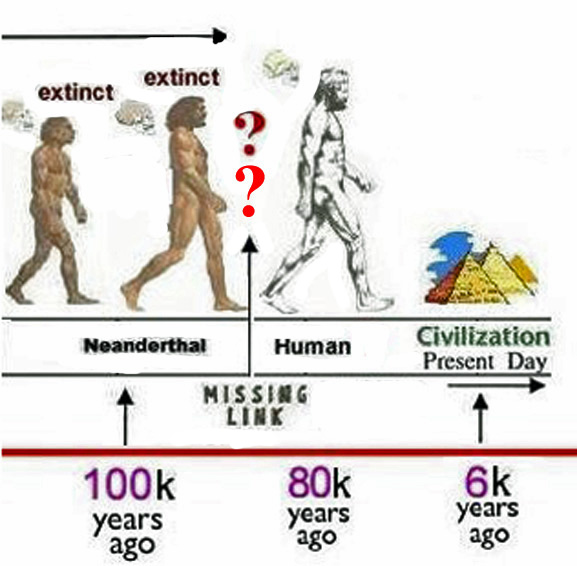

ramidus ankle and hallux than previously recognized. The newly recovered fossils document a greater adaptation to bipedality in the Ar. ramidus of having a mixed locomotor adaptation of terrestrial bipedality and arboreal clambering, we broaden our understanding of the nature of its locomotor pattern by documenting better the function of the hip, ankle, and foot. While we reinforce the original functional interpretations of Ar.
#THE MISSING LINK IN EVOLUTION MANUAL#
ramidus fossils from the Gona Project study area, Ethiopia, that includes a fragmentary but informative partial skeleton (GWM67/P2) and additional isolated manual remains.

Here, we present the results of an analysis of additional early Pliocene Ar. ramidus locomotion has been collected from the Aramis area of the Middle Awash Research Project in Ethiopia. To date, all of the fossil evidence of Ar. That chimpanzees and gorillas independently resorted to a more terrestrial existence, with their signature knuckle-walking pattern (Kivell and Schmitt, 2009 Simpson et al., 2018), further complicates our understanding of the evolution of their distinctive locomotor anatomy.įunctional analyses of the 4.4 Ma hominin Ardipithecus ramidus postcrania revealed a previously unknown and unpredicted locomotor pattern combining arboreal clambering and a form of terrestrial bipedality. As noted elsewhere (Latimer et al., 1981 Lovejoy et al., 2009d Sanders et al., 2010 White et al., 2015), the African apes have followed their own evolutionary adaptive history to high canopy foraging and their current locomotor anatomy is not that of our shared ancestor. “The fortuitous discovery of the Malapa fossils and other similarly fortuitous recent finds should be reminders to us all that there is still so much to discover about our evolutionary past,” the authors concluded.The absence of many modern ape traits in the Ardipithecus skeleton, including long medial metacarpals, reduced pollex with absence of the flexor pollicis longus tendon or its transfer to the index finger (Chapman, 1878, 1879 Straus, 1949), complex carpometacarpal articulations (Selby et al., 2016), forelimb elongation, hindlimb and tarsal shortening, and stiffening of the torso, especially the lumbopelvic region (Lovejoy and McCollum, 2010), reinforces our understanding of the degree of specialization by the extant large-bodied apes to high-canopy arboreality.

sediba, but those fossils would still be there, still encased in calcified clastic sediments, still waiting to be discovered.” “If those events had occurred instead, our science would not know about Au. “Imagine for a moment that Matthew stumbled over the rock and continued following his dog without noticing the fossil,” they added.

Sediba was discovered by Matthew Berger, then a nine-year-old, who happened to stop and examine the rock he tripped over while following his dog Tau away from the Malapa pit,” they wrote. The researchers of the paper to highlight the remarkable story of how the fossils were found, pointing out that other dramatic clues to humanity’s history are still waiting to see the light of day. The hands have grasping capabilities, which are more advanced than those of Homo habilis, suggesting it, too, was an early tool-user. The secret to making a scientific discoveryĪustralopithecus sediba’s hands and feet, for instance, show it was spending a good amount of time climbing in trees. Their discovery set off years of debate in the scientific community, with some rejecting the idea that they were from a previously undiscovered species with close links to the homo genus and others floating the idea that they were from two different species altogether.īut the new research has laid those suggestions to rest, and outlined “numerous features” the skeletons share with fossils from the homo genus. “Australopithecus” means “southern ape,” a genus of hominins which lived some 2 million years ago. Two partial australopith skeletons – a male and a female - were found in 2008 at a collapsed cave in Malapa, in South Africa’s “Cradle of Humankind.” AFP PHOTO / ALEXANDER JOE (Photo credit should read ALEXANDER JOE/AFP/Getty Images) ALEXANDER JOE/AFP/AFP/Getty Images Baptized Australopithecus sediba, the partially fossilized specimens - an adult female and a juvenile male - were found in 2008 in a cavern 40 kilometers (24 miles) from Johannesburg. Two skeletons of a new hominid species dating back two million years and found in South Africa have shed light on a previously unknown stage in human evolution, scientists said today. The remains of an hominid, may be one of the most significant palaeoanthropological discoveries in recent times, are unveiled on Apduring a press conference in Maropeng.


 0 kommentar(er)
0 kommentar(er)
